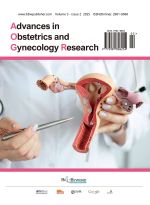Exploration of High-Risk HPV Genotyping Test as an Initial Screening Method for Cervical Cancer
Abstract
Objective: The purpose of this study was to evaluate the clinical value of high-risk HPV typing as a primary screening method for cervical cancer. Methods: From July 2023 to June 2024, 871 women, aged 23 to 77 years old, with an average age of (42.5 ± 3.45) years old, were selected for initial screening of cervical cancer in the health examination center and gynecological clinic of the hospital. All patients underwent HPV-DNA typing and cervical fluid-based thin-layer cytology (TCT). Colposcopic cervical biopsy was performed in women with high-risk HPV single or multiple infection or with TCT ≥ ASC-US. The diagnostic efficacy of HPV-DNA typing, TCT and HPV + TCT combined detection was calculated using the pathological results of biopsy as the gold standard. Results: Compared with TCT alone, HPV-DNA typing was significantly more sensitive in the diagnosis of cervical lesions (P < 0.05), and the rate of missed diagnosis was significantly reduced (P < 0.05). At the same time, the efficacy of the HPV-DNA typing test is similar to that of HPV + TCT combined screening. In terms of misdiagnosis rate and specificity, there was no statistical difference among the three screening strategies (P > 0.05). Conclusion: HPV-DNA typing alone has the same effect as TCT + HPV combined screening for cervical cancer.
References
Duan Y, Yin R, 2024, Progress in Immunotherapy for Cervical Cancer. Journal of Practical Obstetrics and Gynecology, 40(10): 769–773.
Perkins RB, Wentzensen N, Guido RS, et al., 2023, Cervical Cancer Screening: A Review. JAMA, 330(6): 547–558.
Bedell SL, Goldstein LS, Goldstein AR, et al., 2020, Cervical Cancer Screening: Past, Present, and Future. Sex Med Rev, 8(1): 28–37.
Zhai J, Gu L, Fan Y, et al., 2024, Correlation Analysis Between High-Risk Human Papillomavirus Load and Cervical Precancerous Lesions. Journal of Hebei North University (Natural Science Edition), 40(10): 11–13 + 19.
Kou Y, Zhang Y, Yao D, 2024, Relationship Between High-Risk Human Papillomavirus Infection and Clinical Characteristics, Immunohistochemical Indicators, and Prognosis of Cervical Cancer Patients. Oncology Progress, 22(1): 56–59.
Zhong C, 2023, Clinical Diagnostic Value of Cervical Liquid-Based Cytology Combined With Cervical Tissue Biopsy in Patients With Cervical Cancer. Primary Medical Forum, 27(32): 73–75 + 108.
Hazazi A, Khan FR, Albloui F, et al., 2024, Signaling Pathways in HPV-Induced Cervical Cancer: Exploring the Therapeutic Promise of RNA Modulation. Pathol Res Pract, 263: 155612.
Zhou Y, Shao J, Huang Q, 2024, Effects of Lactobacillus Combined With Kushen Gel on Vaginal Microecology and Micro-Inflammatory Indicators in Female Patients With High-Risk HPV Infection of the Cervix. Liaoning Medical Journal, 38(6): 22–26.
Dovnik A, Poljak M, 2023, The Role of Methylation of Host and/or Human Papillomavirus (HPV) DNA in Management of Cervical Intraepithelial Neoplasia Grade 2 (CIN2) Lesions. Int J Mol Sci, 24(7): 6479.
Derbie A, Mekonnen D, Woldeamanuel Y, et al., 2020, HPV E6/E7 mRNA Test for the Detection of High-Grade Cervical Intraepithelial Neoplasia (CIN2+): A Systematic Review. Infect Agent Cancer, 15: 9.

